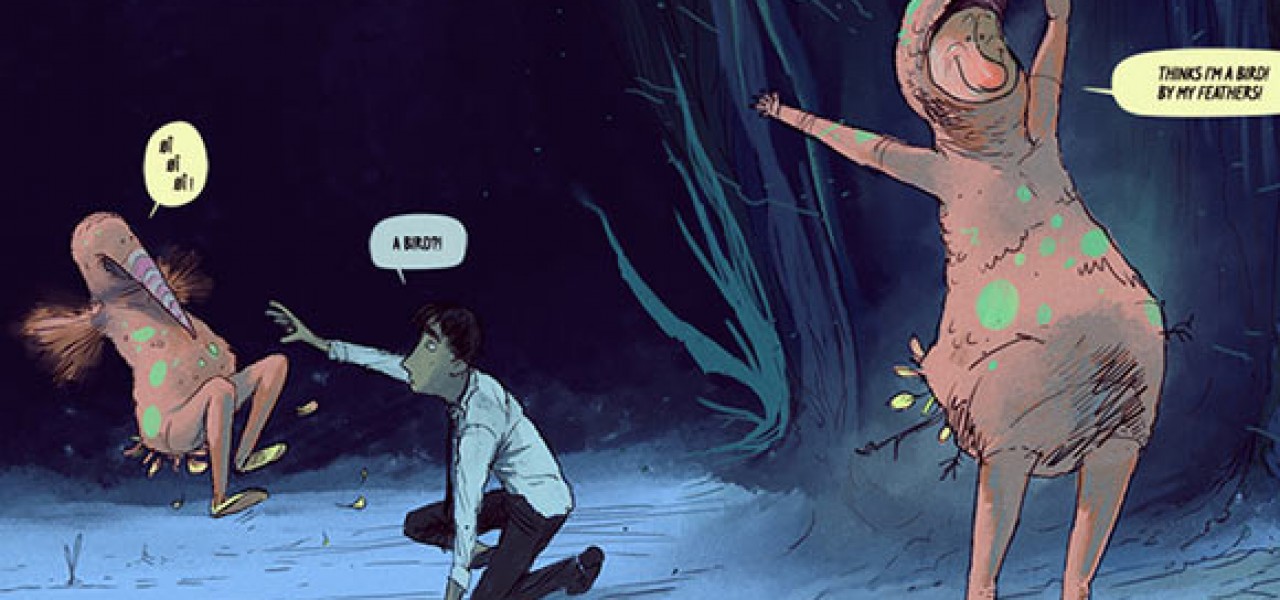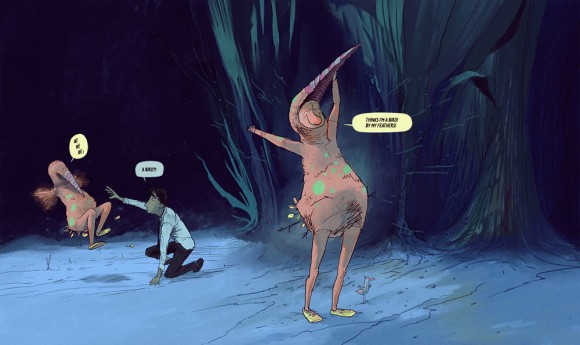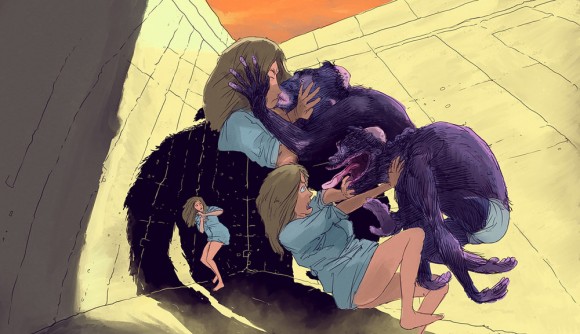

Fons Schiedon Reimagines Mozart’s ‘The Magic Flute’ As A Motion Comic

In his lifetime, Wolfgang Amadeus Mozart’s legendary two-act opera The Magic Flute was a pro-Enlightenment success, which brought its creator a measure of happiness before he passed away mere months after its Vienna premiere in 1791. Today, The Magic Flute fights for elbow room in a new century abundant with competing fairy tales.
Can reimagining one of Mozart’s greatest works as a motion graphic novel help increase the timeless allegory’s influence as time marches on?
“Traditional comics are great at leaving things to the imagination; readers fill in blanks, and that’s exciting,” Fons Schiedon, director and designer of The Land of the Magic Flute, told Cartoon Brew via email. “But I think there is a tricky balance when comics and animation come together, because you have to be careful about the expectation you create. You can easily run into a disconnect when you give voice and movement to still characters. It emphasizes stillness rather than enhancing it, so I didn’t want to do that, which is why The Land of the Magic Flute’s sound design and animation are mostly limited to backgrounds and effects, which serve to create atmosphere and life, but leave it to the reader to do the same for the characters.”

The New York-based Schiedon and his small but dedicated team, which includes his frequent collaborators — São Paulo, Brazil-based animation studio Birdo — as well as writer Benjamin Schreuder and sound designer Philippe Lambert, worked over the last two years on The Land of the Magic Flute. The motion comic was released by Berlin’s Interactive Media Foundation with a younger target audience in mind, the IMF’s Kerstin Anicker told Cartoon Brew.
“It combines various techniques and languages from different media, such as classical illustration and animation with digital storytelling and the language of comics, as well as film score with opera,” explained Anicker. “The hand-drawn illustrations and animations are loosely inspired by the staging and set design of our partners at the Bregenz performing arts festival in Austria, while live recordings of the Vienna Symphony Orchestra and singers from the Bregenz production provide the foundation for the sound design, which plays with and deconstructs Mozart’s original composition. Seven complete arias are accessible as moments of interaction in the graphic novel, reinforcing the connection to the classic.”

That connection is paramount, given The Magic Flute’s centuries of influence and adaptation, which broadly ranges from literature to plays to films and cartoons. Staying faithful to Mozart’s opera while providing points of entry to a younger demo was a must.
“The Magic Flute is arguably Mozart’s most universally loved and recognized opera, with a tremendous amount of symbolism, so we decided to reduce and expand on certain themes relevant to the contemporary narrative structure we wanted to create,” Schiedon said. “The main theme of dark versus light, which the opera doesn’t equate to good versus evil, is something we left at our adaptation’s core. It’s far more ambiguous about morality, which is something we hope to have respected.”

Compressing Mozart’s ambitious vision into a Flash-based motion comic came after considering, then abandoning, a few other platforms, added Schiedon. While attractive, they would have led to a more complex and clogged pipeline, he said, which The Land of the Magic Flute’s international team already possessed in abundance.
“Flash is more or less a platform on its way out, but it’s perfectly capable of delivering the rich 2D animated quality that I wanted, while offering designer- and animator-friendly tools,” he said. “We could move relatively smoothly between animation, programming, and design, drawn in Manga Studio, although our challenge has always been the vast amount of assets, over 320 multi-layer panels — many of which include some form of animation, and all of which include several layers of sound and sound effect cues, as well as speech bubbles in two languages. Each asset required a degree of manual positioning and timing on the back end.”

The accessibility of Flash is always a concern, so Schiedon and his team instead offer mobile and other users potentially lacking Flash plugins a video playout of The Land of the Magic Flute. But their shared goal of making something special and relevant for a new generation of Mozart adopters seems to have been achieved — even if it was achieved in a motion comic rather than an animated feature.
“For this story, I envisioned a rich, detailed world,” concluded Schiedon. “I grew up reading Moebius and Heavy Metal, so I wanted lovingly crafted hand-drawn pictures with painterly effects. If I were to bring all that to life at a 45-minute length, it would mean a production of an entirely different scope. The motion comic is a great opportunity to work ambitiously, but with a tiny team and limited means.”
A making-of film about the project:
To experience the motion comic, visit LandoftheMagicFlute.com.

.png)